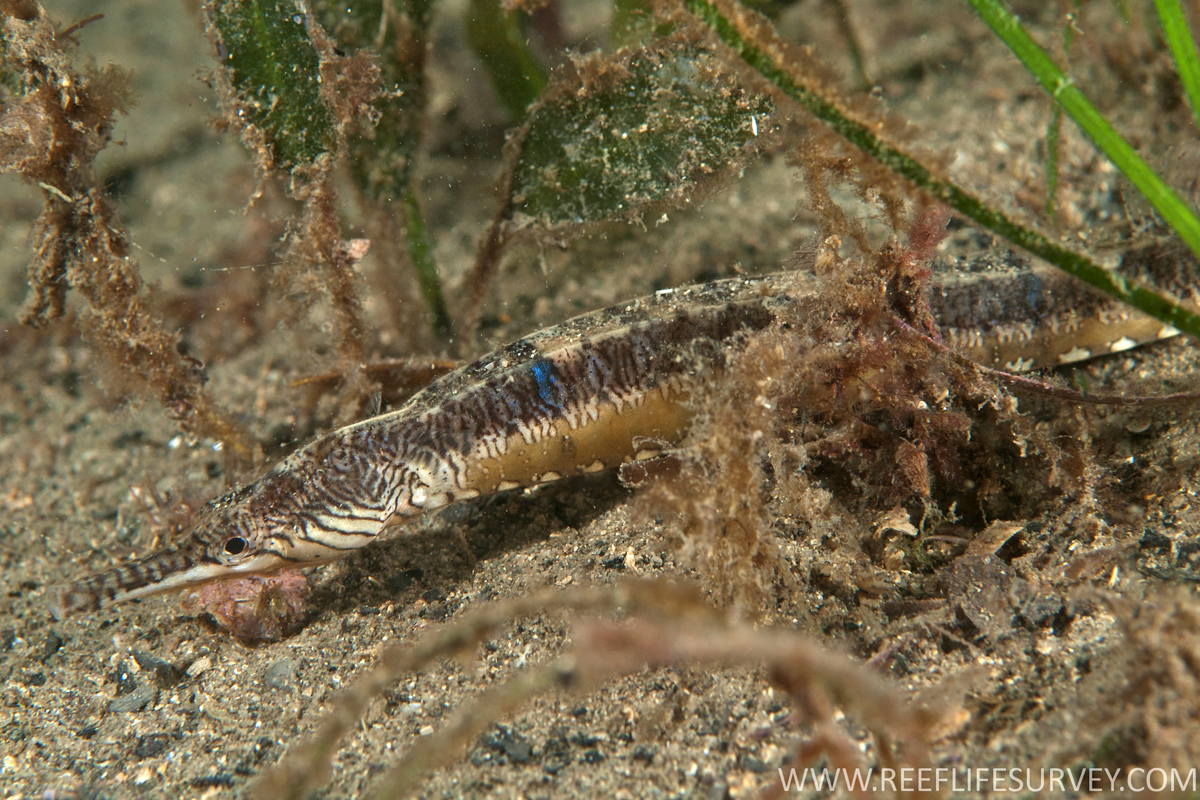Tiger Pipefish, Filicampus tigris (Castelnau 1879)

A Tiger Pipefish, Filicampus tigris, in Nelson Bay, New South Wales. Source: Ian V. Shaw / Reef Life Survey. License: CC by Attribution
A greenish-brown pipefish, usually with 10-12 dark bluish bands across the back and sides of the trunk, a silvery-blue spot on each side just above the inferior ridge, and narrow diagonal dark bars on the side of the head behind the snout. Juveniles and sub-adults have dermal appendages on the head and body.
Tiger Pipefish, Filicampus tigris (Castelnau 1879)
More Info
|
Distribution |
Relatively common in subtropical waters of Australia's east and west coasts. A relic population also occurs in the warmer waters of Spencer Gulf, South Australia. Inhabits shallow seagrass beds and sponge, mud, sand, rock, and rubble areas in depths of 2-30 m. |
|
Features |
Dorsal fin 24-27; Pectoral fin 14-16: Anal fin 4; Caudal fin 8; Trunk rings 17-19; Tail rings 34-38. Body slender, elongate, trunk moderately shallow, body posterior to dorsal fin markedly longer than that before dorsal fin; ridges on head and body without prominent denticulations; head aligned with body; snout moderately long, snout length 38-50% HL, depth 12-35% snout length; dermal flaps usually on head and/or body in juveniles, usually absent from head of adults. Dorsal-fin base of moderate length, positioned centrally on back; anal fin tiny, below centre of dorsal fin; caudal fin very small, rounded; pectoral fins small. |
|
Size |
Attains 350 mm SL |
|
Colour |
Body greenish brown, usually with 10-12 dark bluish bands, each about one ring wide, crossing top and sides of trunk, sometimes encircling tail; each trunk ring usually with a semicircular, iridescent, silvery spot on each side just above the inferior ridge; side of head behind snout usually with diagonal dark bars in subadults and adults, sometimes absent in young. |
|
Feeding |
Feeds on aggregations of mysid shrimps in sheltered bays adjacent to tidal channels. |
|
Biology |
Breeds during the summer months. Eggs are brooded by the males in a semi-exposed pouch under the trunk. The pouch folds fall well short of the midline of the egg-filled pouch. Males may begin brooding at 175 mm SL. Several hundred red eggs are carried in the male brood pouch. Pouch young are 8 mm SL with 7-8 developed caudal fin rays; tail with single median dorsal fleshy process just in front of caudal fin base in most specimens; head and body with minute dark brown chromatophores, most abundant on the dorsal midline. |
|
Conservation |
Marine listed under the Environment Protection and Biodiversity Conservation Act 1999. Listed as protected under New South Wales and South Australian Fisheries Management Acts. |
|
Remarks |
The west coast population differs from that of the east coast in usually having 19 rather than 18 trunk rings. |
|
Similar Species |
|
|
Etymology |
Filicampus is from the Latin, filum meaning thread and the Greek, kampe for bent or curvature. The specific name tigris is from the Latin tigris for tiger in reference to the striped colour pattern. |
|
Species Citation |
Syngnathus tigris Castelnau 1879, Proc. Linn. Soc. N.S.W. (1)3(4): 397, Port Jackson, NSW. |
|
Author |
Thompson, V.J. & D.J. Bray 2017 |
|
Resources |
Tiger Pipefish, Filicampus tigris (Castelnau 1879)
References
Castelnau, F.L. 1879. Essay on the ichthyology of Port Jackson. Proc. Linn. Soc. N.S.W. (1)3(4): 347-402.
Dawson, C.E. 1977. Synopsis of Syngnathine pipefishes usually referred to the genus Ichthyocampus Kaup, with description of new genera and species. Bull. Mar. Sci. 27(4): 595-650.
Dawson, C.E. 1985. Indo-Pacific Pipefishes (Red Sea to the Americas). Gulf Coast Research Laboratory, Ocean Springs, Mississippi. 230 pp.
Dawson C.E., Yasuda, F. & Imai, C. 1979. Elongate dermal appendages in species of Yozia (Syngnathidae) with remarks on Trachyrhamphus. Japan. J. Ichthyol. 25(4): 244-250.
Gomon, M.F. 1994. Family Syngnathidae. pp. 440-474 in Gomon, M.F., C.J.M. Glover & R.H. Kuiter (eds). The fishes of Australia's south coast. State Print, Adelaide: 992 pp, 810 figs.
Gray, C.A., Chick, R.C. & McElligot, D.J. 1998. Diel changes in assemblages of fishes associated with shallow seagrass and bare sand. Estuarine, Coastal and Shelf Science 46(6): 849-859.
Gray, C.A., McElligot, D.J. & Chick, R.C. 1996. Intra- and inter-estuary differences in assemblages of fishes associated with shallow seagrass and bare sand. Marine and Freshwater Research 47(5): 723-735.
Kendrick, A.J. & Hyndes, G.A. 2003. Patterns in the abundance and size distribution of syngnathid fishes among habitats in a seagrass-dominated marine environment. Estuarine and Coastal Shelf Science 57: 631-640.
Kendrick, A.J. & Hyndes, G.A. 2005. Variations in the dietary compositions of morphologically diverse syngnathid fishes. Environmental Biology of Fishes 72: 415-427.
Kuiter, R.H. 1993. Coastal Fishes of South-eastern Australia. Crawford House Press, Bathurst, 437 pp.
Kuiter, R.H. 2000. Seahorses, Pipefishes and their Relatives. TMC Publishing, Chorleywood, UK, 240 pp.
Pollom, R. 2016. Filicampus tigris. The IUCN Red List of Threatened Species 2016: e.T65367453A67624788. http://dx.doi.org/10.2305/IUCN.UK.2016-1.RLTS.T65367453A67624788.en. Downloaded on 01 July 2017.
Whiteman, E.A. & I.M. Côté. 2004. Monogamy in marine fishes. Biol. Rev. 79: 351-375.





